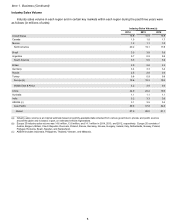Ford 2014 Annual Report Download - page 19
Download and view the complete annual report
Please find page 19 of the 2014 Ford annual report below. You can navigate through the pages in the report by either clicking on the pages listed below, or by using the keyword search tool below to find specific information within the annual report.
Item 1. Business (Continued)
Other National Requirements. The EU and many countries around the world have established vehicle safety
standards and regulations, and are likely to adopt additional or more stringent requirements in the future. The European
General Safety Regulation introduced United Nations Economic Commission for Europe (“UN-ECE”) regulations, which
will be required for the European Type Approval process. EU regulators also are focusing on active safety features such
as lane departure warning systems, electronic stability control, and automatic brake assist. Globally, governments
generally have been adopting UN-ECE based regulations with minor variations to address local concerns. Any difference
between North American and UN-ECE based regulations can add complexity and costs to the development of global
platform vehicles, and we continue to support efforts to harmonize regulations to reduce vehicle design complexity while
providing a common level of safety performance; several recently launched bilateral negotiations on free trade can
potentially contribute to this goal. New safety and recall requirements in China, India, and Gulf Cooperation Council
countries also may add substantial costs and complexity to our global recall practice. In South America, additional safety
requirements are being introduced or proposed in Argentina, Brazil, Chile (mainly for heavy vehicles), Ecuador, and
Uruguay, influenced by Latin NCAP, which may be a driver for similar actions in other countries. In Canada, regulatory
requirements are currently aligned with U.S. regulations. However, recent amendments to the Canadian Motor Vehicle
Safety Act could introduce broad powers to the Minister of Transport to order manufacturers to submit a notice of defect or
non-compliance when the Minister considers it would be in the interest of safety.
EMPLOYMENT DATA
The approximate number of individuals employed by us and entities that we consolidated as of December 31, 2014
and 2013 was as follows (in thousands):
2014 2013
Automotive
North America 90 84
South America 16 18
Europe 47 50
Middle East & Africa 3 3
Asia Pacific 25 20
Financial Services
Ford Credit 6 6
Total 187 181
The year-over-year increase in employment primarily reflects hiring in North America and Asia Pacific to support
product-led growth initiatives and increased vehicle production.
Substantially all of the hourly employees in our Automotive operations are represented by unions and covered by
collective bargaining agreements. In the United States, approximately 99% of these unionized hourly employees in our
Automotive sector are represented by the International Union, United Automobile, Aerospace and Agricultural Implement
Workers of America (“UAW” or “United Auto Workers”). Approximately 1.5% of our U.S. salaried employees are
represented by unions. Most hourly employees and many non-management salaried employees at our operations outside
of the United States also are represented by unions.
In 2011, we entered into a four-year collective bargaining agreement with the UAW. The agreement covers
approximately 50,000 employees, and maintained our progress on improving competitiveness in the United States by
providing for lump-sum payments (in lieu of general wage increases and cost of living increases) and continuation of an
entry-level wage structure.
In 2014, we negotiated collective bargaining agreements (covering wages, benefits and/or other employment
provisions) with labor unions in Argentina, Brazil, France, Germany, Italy, Mexico, and Thailand.
In 2015, we will negotiate collective bargaining agreements (covering wages, benefits and/or other employment
provisions) with labor unions in Brazil, China, France, Germany, Italy, Mexico, Romania, Russia, Thailand, United
Kingdom, and United States.
ENGINEERING, RESEARCH, AND DEVELOPMENT
We engage in engineering, research, and development primarily to improve the performance (including fuel
efficiency), safety, and customer satisfaction of our products, and to develop new products. Engineering, research, and
development expenses for 2014, 2013, and 2012 were $6.9 billion, $6.4 billion, and $5.5 billion, respectively.
13
























